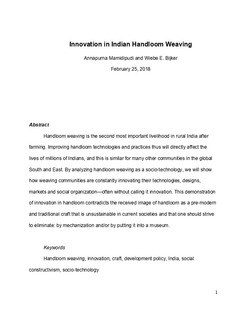| dc.contributor.author | Mamidipudi, Annapurna | |
| dc.contributor.author | Bijker, Wiebe Eco | |
| dc.date.accessioned | 2019-09-04T07:59:30Z | |
| dc.date.available | 2019-09-04T07:59:30Z | |
| dc.date.created | 2018-09-27T17:38:02Z | |
| dc.date.issued | 2018 | |
| dc.identifier.citation | Technology and culture. 2018, 59 (3), 509-545. | nb_NO |
| dc.identifier.issn | 0040-165X | |
| dc.identifier.uri | http://hdl.handle.net/11250/2612374 | |
| dc.description.abstract | Handloom weaving is the second most important livelihood in rural India after farming. Improving handloom technologies and practices thus will directly affect the lives of millions of Indians, and this is similar for many other communities in the global South and East. By analyzing hand-loom weaving as a socio-technology, we will show how weaving communities are constantly innovating their technologies, designs, markets, and social organization—often without calling it innovation. This demonstration of innovation in handloom contradicts the received image of handloom as a pre-modern and traditional craft that is unsustainable in current societies and that one should strive to eliminate: by mechanization and/or by putting it into a museum. | nb_NO |
| dc.language.iso | eng | nb_NO |
| dc.publisher | Johns Hopkins University Press | nb_NO |
| dc.title | Innovation in Indian Handloom Weaving | nb_NO |
| dc.type | Journal article | nb_NO |
| dc.type | Peer reviewed | nb_NO |
| dc.description.version | acceptedVersion | nb_NO |
| dc.source.pagenumber | 509-545 | nb_NO |
| dc.source.volume | 59 | nb_NO |
| dc.source.journal | Technology and culture | nb_NO |
| dc.source.issue | 3 | nb_NO |
| dc.identifier.doi | 10.1353/tech.2018.0058 | |
| dc.identifier.cristin | 1615290 | |
| dc.description.localcode | © 2018. This is the authors' accepted and refereed manuscript to the article. The final authenticated version is available online at: http://dx.doi.org/10.1353/tech.2018.0058 | nb_NO |
| cristin.unitcode | 194,62,40,0 | |
| cristin.unitname | Institutt for tverrfaglige kulturstudier | |
| cristin.ispublished | true | |
| cristin.fulltext | original | |
| cristin.qualitycode | 2 | |
